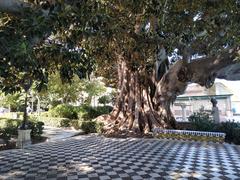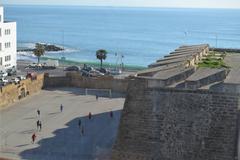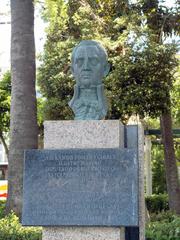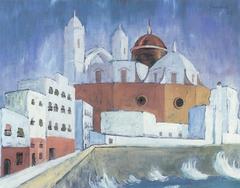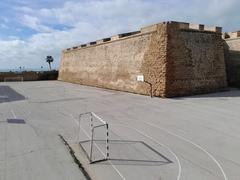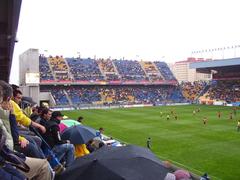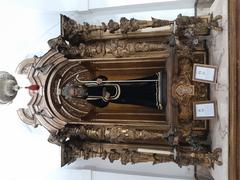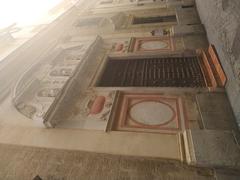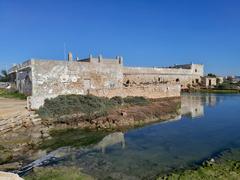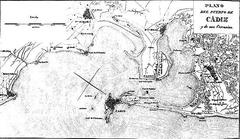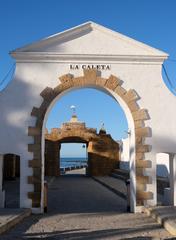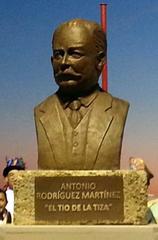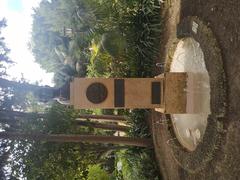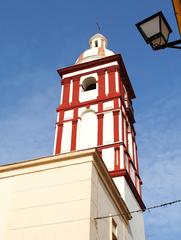Visiting Castillo de Santa Catalina, Cádiz, Spain: Comprehensive Guide to Tickets, Hours, and Tips
Date: 04/07/2025
Introduction
The Castillo de Santa Catalina in Cádiz, Spain, is a striking testament to the city’s maritime heritage and evolving cultural landscape. Overlooking the Atlantic from the edge of La Caleta Beach, this star-shaped fortress has transformed from a vital coastal defense into one of Cádiz’s most dynamic cultural venues. Whether you are passionate about history, architecture, or the arts, this guide provides everything you need to plan your visit, including historical background, architectural highlights, practical visitor information, and recommendations for maximizing your experience (Trek Zone).
Table of Contents
- Introduction
- History and Significance
- Architectural Features
- From Fortress to Cultural Venue
- Visiting Information
- Guided Tours and Activities
- Notable Events and Exhibitions
- Nearby Attractions
- Photography Tips
- Visitor Recommendations and Safety
- Frequently Asked Questions (FAQ)
- Visuals and Media
- Contact Information
- Summary and Recommendations
- References
History and Significance
Commissioned by King Philip II after the devastating 1596 English raid led by Sir Francis Drake, the Castillo de Santa Catalina was built to fortify Cádiz’s vulnerable northern flank (Trek Zone). Military engineer Cristóbal de Rojas designed the fortress in the late 16th century, introducing Italian Renaissance principles of bastioned defense. Its pentagonal, star-shaped plan allowed for strategic crossfire with the nearby Castillo de San Sebastián, together shielding the bay and city from further attack (Guía de Cádiz).
Over time, the castle’s role evolved. It was used as a military prison for political prisoners and later declared a “Bien de Interés Cultural” in 1985, ensuring its preservation and prompting extensive restoration (Guía de Cádiz). Today, it stands as a symbol of Cádiz’s resilience, hosting events and exhibitions that bridge the city’s historic and contemporary identities (Official Cádiz Tourism).
Architectural Features
The fortress’s star-shaped layout, thick stone bastions, and defensive moat exemplify Renaissance military architecture (Wikipedia). Interior features include:
- Barracks and Magazines: Essential for self-sufficiency during sieges.
- Chapel (1693): A simple baroque altar dedicated to Santa Catalina de Alejandría and the Immaculate Conception.
- Prison Cells: Some of which housed notable figures such as Mariano Abasolo and John Downie, reflecting the site’s layered past (Wikipedia).
From Fortress to Cultural Venue
No longer a military outpost, the Castillo de Santa Catalina is a thriving cultural center. Its restored courtyards and vaulted halls now accommodate:
- Art Exhibitions: Both permanent maritime history exhibits and rotating contemporary shows.
- Concerts and Performances: Especially in summer, making the most of the open-air parade ground.
- Workshops and Community Events: Engaging locals and visitors in Cádiz’s living heritage (institucional.cadiz.es).
Notably, the 2025 exhibition “Sobre todo, mujeres” showcased works from 50 female artists, highlighting the venue’s commitment to diversity and modern cultural discourse (diariodecadiz.es).
Visiting Information
Opening Hours
Hours vary by season (Castillo Santa Catalina Official):
Summer (June 16 – September 15):
- Monday to Saturday: 10:00–14:00 and 17:00–21:00
- Sunday: 10:00–15:00
- Holidays/Sundays before holiday Mondays: 10:00–14:00 and 17:00–21:00
Winter (September 16 – June 15):
- Monday to Saturday: 10:00–18:00
- Sunday: 10:00–15:00
- Holidays/Sundays before holiday Mondays: 10:00–18:00
Free admission hours: Wednesdays (seasonal hours apply as per Andalusian Heritage Law 14/2007).
Last entry: 30 minutes before closing.
Ticket Prices
- General: €3.50
- Groups (10+): €2.50 per person
- Reduced (retirees, pensioners, over 65, children 4–12, disabled, large families, students): €1.50
- School groups (15+, Jan–Mar): €1.00
- Night visits: €8.00 (individual), €6.00 (group 15+)
- Free admission: Wednesdays during designated hours; general admission is often free except during special events (Castillo Santa Catalina Official), (Oway Tours).
Accessibility
The castle is partially accessible, with ramps and adapted pathways in main areas. Some upper ramparts and historic sections may be challenging for visitors with reduced mobility. Contact the administration for detailed accessibility information (Cruceristas por el Mundo).
Getting There
Location: Paseo Antonio Burgos s/n, Playa de La Caleta, 11002 Cádiz, Spain (Oway Tours).
- By foot: A scenic 15–20 minute walk from Cádiz’s historic center.
- By bus: City bus lines 2 and 7 stop near La Caleta.
- By car: Limited street parking is available; public transit is recommended (Evendo).
Facilities and Services
- Restrooms: On site.
- Gift Shop: Sells souvenirs and guidebooks.
- Exhibition Rooms: Permanent and temporary displays on history and local culture (Barceló Guide).
- Event Spaces: Used for concerts, workshops, and film festivals.
- Tourist Information: Brochures (mainly in Spanish) at the entrance.
Guided Tours and Activities
While official guided tours are not routinely available from the castle itself, private operators and tour companies often include the site in their itineraries, providing historical context and local legends (Explorial). Seasonal sunset tours and catamaran cruises are also popular, offering unique perspectives of the fortress from the bay (Cruceristas por el Mundo).
Notable Events and Exhibitions
The castle is a hub for:
- Art Exhibitions: Rotating displays of local and international artists.
- Concerts: Open-air performances in summer.
- Workshops: For children and adults, focusing on arts and crafts.
- Film Festivals: Including the renowned Alcances Documentary Film Festival (Barceló Guide).
Event schedules may change; consult the official website for updates.
Nearby Attractions
Enhance your visit by exploring:
- Castillo de San Sebastián: Another historic fortress on a nearby islet.
- Cádiz Cathedral: A baroque and neoclassical masterpiece.
- Roman Theatre: One of the largest in Spain.
- Gran Teatro Falla: Iconic theater for concerts and festivals.
- Museo de Cádiz: Rich archaeological and art collections (World Tourism).
Photography Tips
- Best Light: Late afternoon and sunset for golden-hour shots.
- Top Spots: Ramparts overlooking La Caleta, central courtyard, chapel, and outer walls for dramatic contrasts (Evendo).
- Equipment: Bring a camera or smartphone; tripods are allowed in most open areas.
Visitor Recommendations and Safety
- Allow at least one hour for your visit.
- Summers can be hot (38–40°C); bring water, sunscreen, and a hat (Wanderlust Chloe).
- Wear sturdy shoes for uneven surfaces and stairs.
- Check event schedules to avoid crowded times if you prefer a quieter experience.
- Children should be supervised near ramparts.
- Pets policies vary; check in advance for current regulations.
- Drone use is prohibited unless expressly authorized.
Frequently Asked Questions (FAQ)
How do I buy Castillo de Santa Catalina tickets?
Tickets are available on site. For special events or night visits, online reservations may be required.
Are there free admission hours?
Yes, on Wednesdays during specified hours.
Is the castle wheelchair accessible?
Partially. Some areas are accessible, but upper ramparts and certain sections have limited access.
Are guided tours available?
Private operators offer guided visits. Check local tour providers or the castle website for options.
What is the best time to visit?
Late afternoon and sunset provide the best light and fewer crowds.
Are there facilities for visitors?
Restrooms, a gift shop, and exhibition spaces are available; cafés and restaurants are nearby.
Visuals and Media
Alt text: Sunset view of Castillo de Santa Catalina with golden skies over La Caleta Beach, Cádiz
Alt text: Map highlighting the location of Castillo de Santa Catalina in Cádiz, Spain
Contact Information
- Phone: +34 956 226 333
- Email: [email protected]
- Official Website: castillosantacatalina.es
Summary and Recommendations
The Castillo de Santa Catalina is both a monument of Cádiz’s enduring resilience and a contemporary hub of art, music, and community. Its strategic location, architectural ingenuity, and evolving role from fortress to cultural venue make it a must-see for any visitor (Trek Zone; institucional.cadiz.es). With flexible hours, affordable admission, and partial accessibility, it welcomes a wide range of guests. For the best experience, check the official website for up-to-date information and consider combining your visit with other historic landmarks nearby. Download the Audiala app for real-time updates, offline maps, and exclusive travel tips.
References
- Castillo de Santa Catalina Cádiz: History, Visiting Hours, Tickets & Visitor Guide, 2024, Trek Zone
- Visiting the Castillo de Santa Catalina: Cádiz’s Historic Fortress and Cultural Hub, 2025, institucional.cadiz.es
- Visiting the Castillo de Santa Catalina: Hours, Tickets, and Cádiz Historical Sites Guide, 2024, Official Cádiz Tourism
- Castillo de Santa Catalina Visiting Hours, Tickets, and Guide to Cádiz’s Historic Site, 2025, castillosantacatalina.es
- Visiting the Castillo de Santa Catalina: Cádiz’s Historic Fortress and Cultural Hub, 2024, diariodecadiz.es
- Visiting the Castillo de Santa Catalina: Cádiz’s Historic Fortress and Cultural Hub, 2024, idealista.com
- Guía de Cádiz
- Oway Tours
- Evendo
- Cruceristas por el Mundo
- Barceló Guide
- Explorial
- Wanderlust Chloe
- World Tourism
